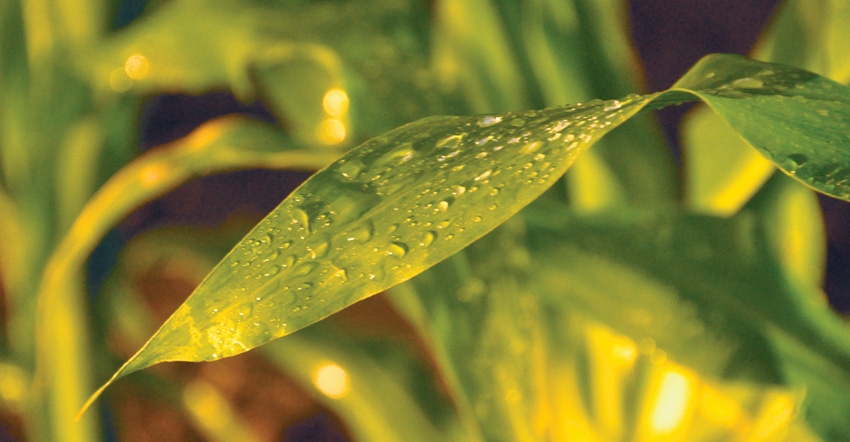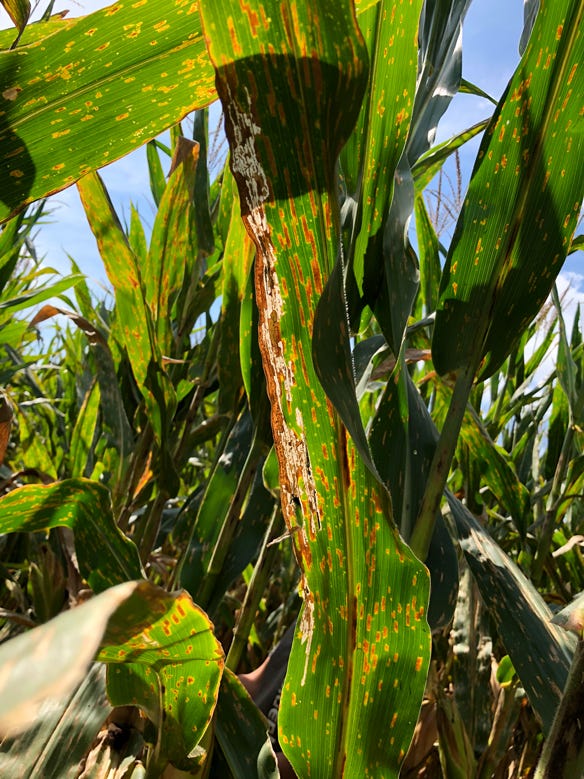
Humidity saved some areas of western Illinois from the drought that plagued Missouri throughout the 2018 growing season.
Moisture’s flip-side effect in Illinois brought on heavy fungal disease pressure, particularly in pockets that got too much rain, such as eastern parts of the state. This forced farmers to consider applying fungicide despite tight margins caused by low commodity prices.
“There was more rain to the east, and as you moved west, there was less,” says Stephanie Porter, agronomist with Golden Harvest. “It was kind of like: eastern Illinois? Too much rain early. Western Illinois? Not enough in some areas. But the Springfield area? Just right.”
Porter says Illinois’ rain came late, which brought diseases and poor seed quality issues to many of the farmers in the southern parts of the state. Unusually high heat compounded the issue by delaying fungal diseases like gray leaf spot from being apparent when corn tasseled in July.
“Most people spray at tassel,” Porter explains. “I had a lot of people realize at brown silk, ‘Oh my gosh, I should have sprayed; what do I do now?’ I told them not to, because you’re not going to get any yield benefit out of it, but it could help with standability.”

SPOTS: Gray leaf spot may not have been noticeable at tassel due to drought or heat, but conditions favorable for disease development (75 to 85 degrees F plus moisture and humidity) came in mid-July. “This led to heavy disease severity, depending on hybrid and location,” says Golden Harvest agronomist Stephanie Porter.

Average temperatures for May, June and July in Illinois were higher than the drought years of 2012, 1988 and 1983. Humidity levels, however, remained high throughout a hot season, largely saving the crop in the western portion of the state by keeping moisture in the plants, says Matt Montgomery, Pioneer field agronomist covering central and western Illinois.
“The heat caused rapid crop development and minimal mineralization in some of the secondary nutrients that we needed,” he says. “There was a point in May, beginning of June, where we were literally 15 days ahead of where we were in 2017.”
The gap closed to just a few days by the end of July in western areas like Quincy, thanks to what Montgomery calls a “miraculous” turn, with cool evenings bringing temperature relief and some rainfall.
However, in some spots, “moisture and heat stress did not break soon enough,” he says.
Planting early pays off
Going into the 2018 season, based on plot data thus far, it appears there was a slight bias for corn hybrids of higher and lower maturities to have higher yields, Porter says.
“As I look at planting dates and corn yields, there’s a lot of 110-day to 112-day corn varieties that suffered in some areas if they were planted after the 25th” of April, she says. “We had some major heat or high minimum temperatures at pollination in some areas, and I believe this caused these hybrids’ plants to suffer.”
Does fungicide pay?
Porter says many of the farmers she works with in western Illinois are more likely to use fungicide on soybeans when compared to corn. Many saw soybean yield increases from 5 to 15 bushels per acre with fungicide use in 2018. They believe that using fungicide on soybeans is consistently paying off for them year after year, she says.
“Like Stephanie, I have an area in my territory that definitely has seen at least 20- to 30-bushel differences in using fungicide compared with not using it on corn, and we have also seen a few to several bushel differences in beans thanks to exceptional disease pressure,” Montgomery adds.
Both agronomists went to fields in Illinois with low disease pressure that didn’t spray fungicide at all, citing northern parts of the state that were so dry, many farmers didn’t see a need to. However, when it became clear conditions were primed for disease and other pests, they recommended applying not only fungicide, but also an insecticide in corn and soybeans.
“As we enter the next growing year, I’m going to have more conversations with growers,” Montgomery says. “You know, if the weather looks more conducive for disease, will you or will you not spray? … It made a dramatic difference this year, and it actually changed the experience for growers from very negative to very positive in certain locations.”
About the Author(s)
You May Also Like




